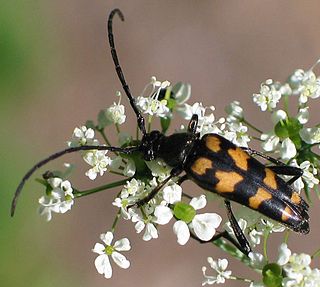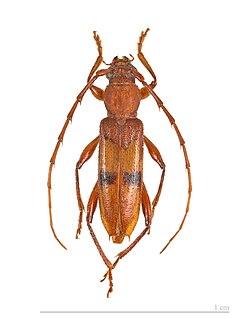| Styloxus | |
|---|---|
| Scientific classification | |
| Kingdom: | |
| Phylum: | |
| Class: | |
| Order: | |
| Suborder: | |
| Family: | |
| Genus: | Styloxus |
Styloxus is a genus of beetles in the family Cerambycidae, containing the following species: [1]

Beetles are a group of insects that form the order Coleoptera, in the superorder Endopterygota. Their front pair of wings are hardened into wing-cases, elytra, distinguishing them from most other insects. The Coleoptera, with about 400,000 species, is the largest of all orders, constituting almost 40% of described insects and 25% of all known animal life-forms; new species are discovered frequently. The largest of all families, the Curculionidae (weevils) with some 80,000 member species, belongs to this order. Found in almost every habitat except the sea and the polar regions, they interact with their ecosystems in several ways: beetles often feed on plants and fungi, break down animal and plant debris, and eat other invertebrates. Some species are serious agricultural pests, such as the Colorado potato beetle, while others such as Coccinellidae eat aphids, scale insects, thrips, and other plant-sucking insects that damage crops.
- Styloxus angelesae Noguera, 2005
- Styloxus bicolor (Champlain & Knull, 1922)
- Styloxus fulleri (Horn, 1880)
- Styloxus fuscus Chemsak & Linsley, 1964
- Styloxus lucanus LeConte, 1873
- Styloxus oblatipilis Chemsak & Linsley, 1964
- Styloxus parvulus Chemsak & Linsley, 1964
Styloxus angelesae is a species of beetle in the family Cerambycidae. It was described by Noguera in 2005.
Styloxus bicolor is a species of beetle in the family Cerambycidae. It was described by Champlain and Knull in 1922.
Styloxus fulleri is a species of beetle in the family Cerambycidae. It was described by George Henry Horn in 1880. The members of the Cerambycidae — Longhorn Beetles — family are named for their long antennae, sometimes exceedingly so. The antennae of males are usually longer than those of females, and often the antennae are attached to the head in a strange notch at the front of the eye. Longhorn beetle larvae are called round-headed borers and most feed on dead and decaying wood. Some species feed on living plants. They tunnel inside the wood and so are rarely seen, only emerging as adults. Most species have a limited flight time during which they may be found. Adult longhorn beetles feed on flower nectar, sap, or leaves and bark. They tend to be strong flyers and are sometimes attracted to lights at night. While individuals of some species are almost always the same size, at times there can be rather pronounced variation, both within the same gender and also between males and females. Males can be much smaller than females. One slender brown beetle that has some very distinctive features is Styloxus fulleri. This is a smaller species, at about 12–13 mm in length. The elytra —hardened front wings—do not completely cover the other pair of wings, but end about two-thirds down the length of the body. The antennae are super-long, with very long thin segments. Their eyes are huge on a rather small head.





